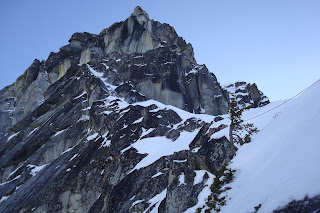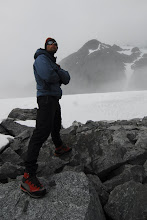Colchuck's NE Buttress climbs the ridge dropping from the left summit
A calm, dark wind blows through the starry sky. From our vantage point Argonaut Peak, Sherpa Peak, and Mt. Stuart stand still and silent in the shadows of winter night. I let my mind relax and I absorb the view that I've seen a hundred times before. I'm not just looking at my surroundings, but rather feeling them to my very bones. My journey to this summit is a culmination of all the adventures I've had on the moutains that surround us. The stories, epics, and triumphs replay in my mind. I feel a peace. I feel at home.
Shaun soaking up the sun on Colchuck Lake
A day earlier, Shaun Johnson and I had left the floor of the Icicle Canyon and climbed upwards as pine forest gave way to thick fir glades. Bright sun lit our path and we sucked up the solar power. After a few hours we broke out onto Colchuck Lake, a frozen expanse cradled by 8,000 foot summits, sweeping moraines, and long, steady slopes.
Breaking trail through deep snow
I closed my eyes and let the sun dig in to me as we ate lunch on the lake. With many cold, hard moments ahead, I relaxed and simply enjoyed being alive.
Cresting the moraine in deep, unconsolidated snow
After redistributing the gear, we headed up towards the NE Buttress of Colchuck Peak, a route I had tried four other times to climb in winter. Above the lake, the deep unconsolidated snow slowed our progress. I knew the conditions on the climb would not be good. I thought about my other failures and decided Shaun and I needed to work with what we were given. The route was not in good nick, but the weather was beautiful and I was determined to keep moving upwards no matter what. With three days of food and bivy gear in the pack, we were equipped to see this mission through to the end.
Leading pitch two
Working with what we were given meant breaking trail through waist deep snow to the first technical pitch. Wading through the powder could have injected doubt into my veins, but I just kept my head down and tried to levitate up the loaded coulior to the base of the route. Our goal for day one was to make it to a bivy perch on top of pitch two. Putting this initial stretch of climbing behind us was crucial. These pitches are some of the most difficult on the route. A filter for what's to come, the snow covered black granite reveals whether you are up to the task or not.
Shaun standing on night one's bivy platform
Even though conditions were poor, I managed to climb the first two pitches with relative ease. Previous experiance helped here. The climbing was insecure and difficult, but I knew what to expect and where I might get some gear. We stomped out a skinny ledge for the tent as fading light cast a pink glow across the sea of peaks that filled the horizon. With the door shut, one could amost forget the 400 foot drop pulling at the edges of the First Light.
Leading across the snow ledges that define the middle of the route
The next morning I found myself leading across the snow ramps that define the middle of the NE Buttress. Although they looked casual, the thin coating of snow was mostly unconsolidated and it took me a few hours to connect climbable terrain across the ramps.
Climbing the key corner pitch that connects weaknesses on the ridge
By mid afternoon, I was under the pitches I had wondered about for so many years. All my previous attempts had ended short of the key passage that snaked above me. The first question mark was a 5.7 slab. Easy in summer, but thin and run out in winter, this stretch put me on the tip of my mono point as I connected small patches of moss and snow. Finding a belay proved challenging, but I finally managed to secure myself under the summer crux, a 5.8 corner with a varied crack sunk in the back. Torques, moss sticks, and an aid move or two pushed me through the corner and on to the upper ridge. A happy feeling surfaced in my being. "We are going to send!", I thought. The sentiment was quickly squelched by my realistic side. We were still 400 feet below the summit in the dead of winter. A narrow focus returned to my mind. It's not over until it's over.
Leading out on the snow arete that defined the upper part of the route
I charged into the sunset, leading a long simul pitch through a sharp snow arete and into a gully of neve. Finally, some sticks and easy climbing! I daggered up the gash towards a belay.
A look back at part of the snow arete
Two more M5 pitches kept me in the moment. Darkness had overtaken us and my world was reduced to the orb of light that radiated from my headlamp. Sparks lit the air when my crampon points scratched the belly of granite we were stuck to. I grunted and tackled each bulge with aggression. I could feel the top in the blackness above.
Our bivy near Colchuck's summit on the morning of day three
Finally, I was released to the summit slopes. With no where higher to go I sat in the snow and belayed Shaun as he worked his way to the top. I soaked up the scene around me as I pulled the rope upwards. Soon, Shaun's headlamp bobbed and weaved over the summit too. We had made it!
We took in the scene for many wordless minutes. I let myself enjoy the feeling of success that overwhelmed us. I recognized the hard work and progression that it took to get here. I thought over the day and the key moments that stood out. I gave thanks to the friends that shared parts of the journey with me.
And then I moved on. The multi year project to make the first winter ascent of the NE Buttress was over. Setting up the tent on the summit plateau, a content tiredness flooded through me. It was time to take this experiance and apply the lessons to another challenge.
Heading home, moving on
*An account of the first winter ascent of the NE Buttress of Colchuck Peak
*Summit was gained on March 9
*Ascent was made by Shaun Johnson and Jens Holsten
*M6 A1, 13 pitches
























